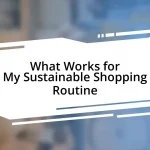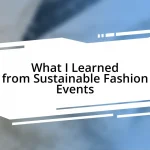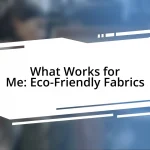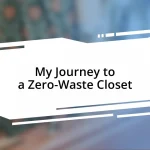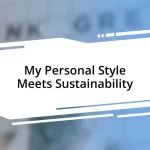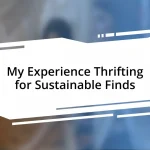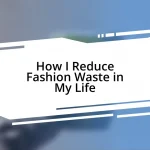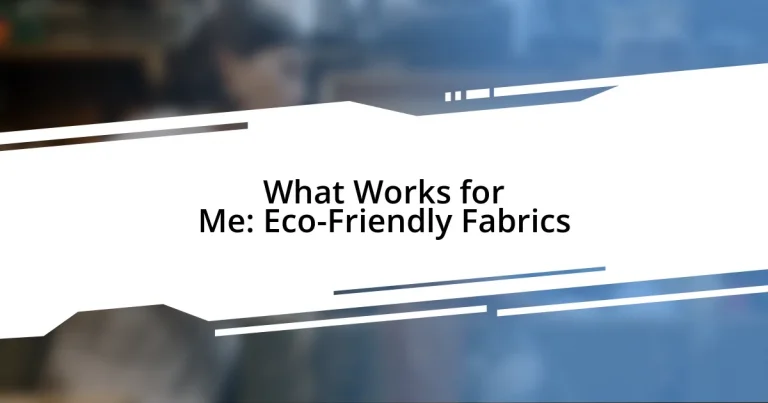Key takeaways:
- The author emphasizes the variety and benefits of eco-friendly fabrics, such as hemp, linen, and Tencel, highlighting their sustainable properties.
- Choosing eco-friendly fabrics not only reduces environmental impact but also supports ethical practices and contributes to personal well-being.
- Caring for eco-friendly fabrics through gentle washing and proper storage enhances their longevity and aligns with a sustainable lifestyle.
- The author shares personal experiences with sustainable brands like Pact, Eileen Fisher, and Reformation, reinforcing the importance of intentional clothing choices.
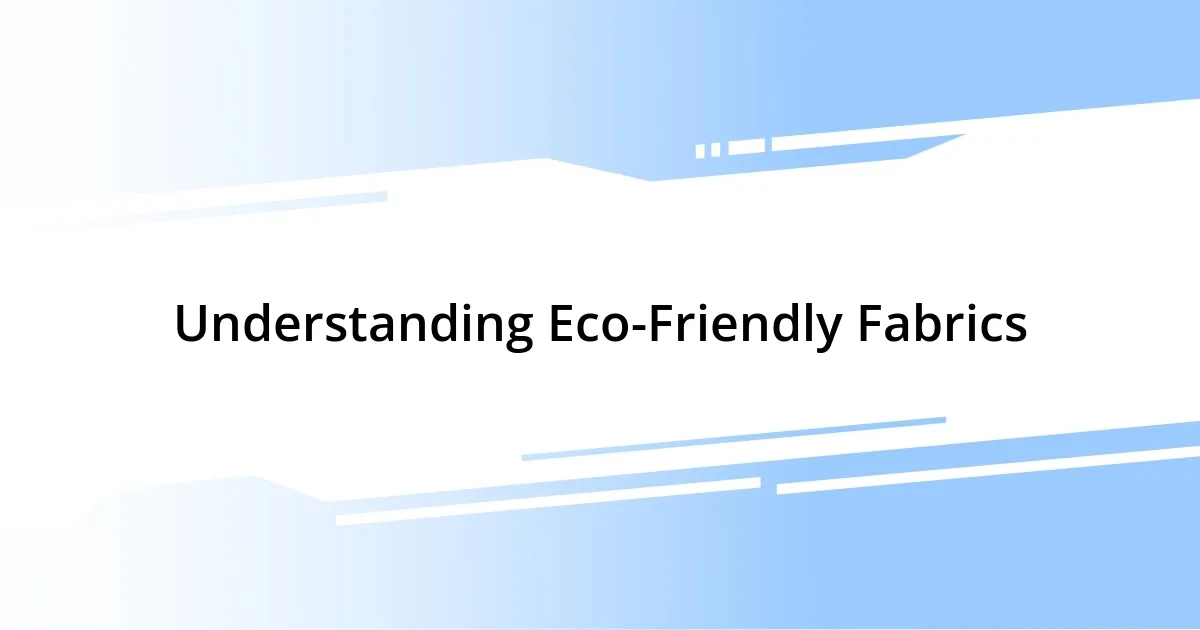
Understanding Eco-Friendly Fabrics
When I first started exploring eco-friendly fabrics, I was surprised at how diverse the options are. From organic cotton to Tencel, each fabric has its unique benefits and environmental impact. It made me question, how often do we consider the story behind the clothing we wear?
I vividly remember the moment I discovered bamboo fabric. It felt like touching a cloud! The softness was astonishing, and knowing it’s derived from a renewable resource made me feel even better about my purchase. Have you ever experienced that satisfaction of choosing a fabric that feels as good as it is good for the planet?
There’s something profoundly empowering about understanding eco-friendly fabrics. Knowing that materials like recycled polyester come from discarded plastics gives me a sense of hope. It’s amazing to think that by choosing the right fabric, we can reduce waste and contribute to a healthier planet. How rewarding is that? Each time I select eco-conscious textiles, I feel I’m part of a larger movement toward sustainability and ethical fashion.
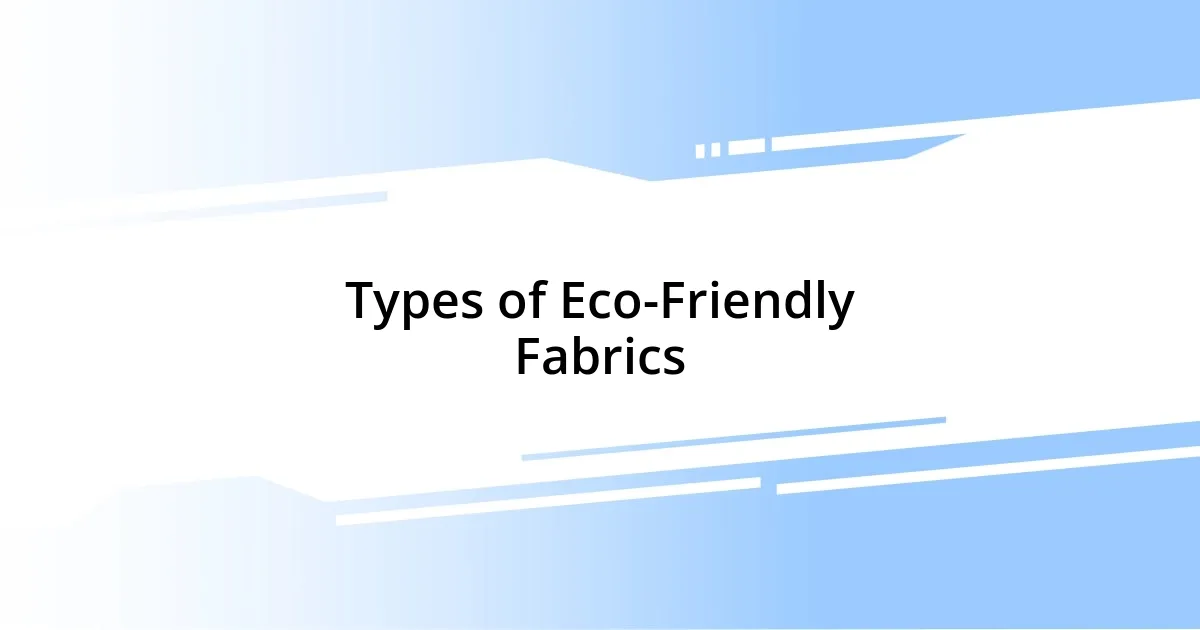
Types of Eco-Friendly Fabrics
The world of eco-friendly fabrics is indeed captivating, with each option offering something unique. One fabric that particularly stands out to me is hemp. Known for its durability, I find it fascinating how this fabric grows quickly and requires minimal water, making it a wonderful choice for sustainable fashion. Its natural strength is a bonus—it’s like wearing a piece of nature that lasts!
Then there’s linen, which reminds me of sunny days spent in cozy, airy tops. Made from flax plants, it’s a biodegradable option that feels good against the skin. I appreciate how linen’s production process is less resource-intensive compared to conventional cotton. Plus, as it softens with each wash, it becomes even more comfortable over time—what’s not to love about that?
Lastly, I can’t help but highlight Tencel, which I recently discovered during a shopping spree. This fabric, made from sustainably sourced wood pulp, is not only soft but also has moisture-wicking properties. I remember wearing a Tencel shirt on a humid day and feeling cool and comfortable—such a fantastic blend of practicality and eco-friendliness. Exploring these types of fabrics has deepened my appreciation for options that prioritize both style and the environment.
| Fabric | Key Characteristics |
|---|---|
| Hemp | Durable, fast-growing, minimal water needed |
| Linen | Biodegradable, breathable, softens with washing |
| Tencel | Moisture-wicking, soft, sustainably sourced |
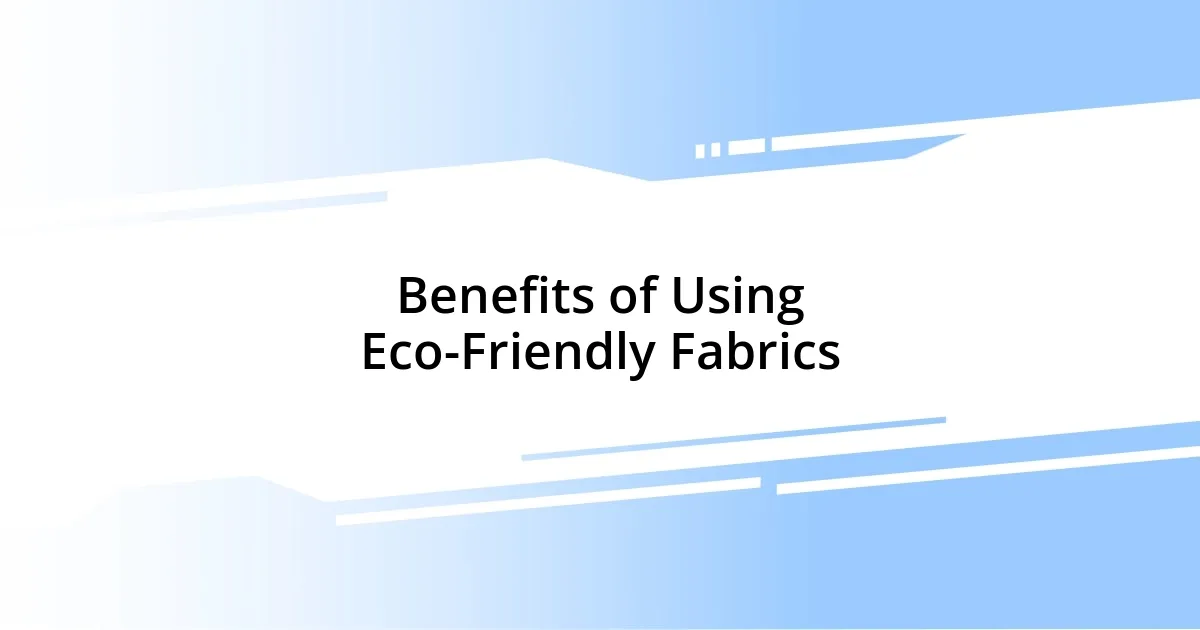
Benefits of Using Eco-Friendly Fabrics
Using eco-friendly fabrics brings a multitude of benefits that extend beyond personal style. When I made the switch to sustainable materials, I noticed an immediate improvement in how I felt about my wardrobe choices. It’s not just about looking good; it’s about the positive impact I can have on the environment. Knowing that I’m supporting practices that promote cleaner water, healthier soils, and reduced pollution is incredibly fulfilling.
Here are a few benefits that stand out for me:
- Reduced Environmental Impact: Eco-friendly fabrics often require fewer pesticides, fertilizers, and chemicals, which leads to healthier ecosystems.
- Longevity and Durability: Many sustainable fabrics, like hemp, are known for their strength, ensuring that my clothing lasts longer and reduces waste.
- Healthier for Skin: Natural fibers are often gentler on the skin, which is a significant blessing for someone like me with sensitive skin.
- Support for Ethical Practices: Choosing these materials often means supporting fair labor practices and local economies, which makes my purchases feel even more meaningful.
Each time I wear something made from organic cotton or Tencel, I can’t help but smile, knowing that my choices resonate with my values and contribute to a healthier planet. Isn’t it amazing how fabric can carry such weight in our lives? I’ve found that integrating eco-friendly fabrics into my life has transformed not just how I dress but how I think about consumption and sustainability in general.
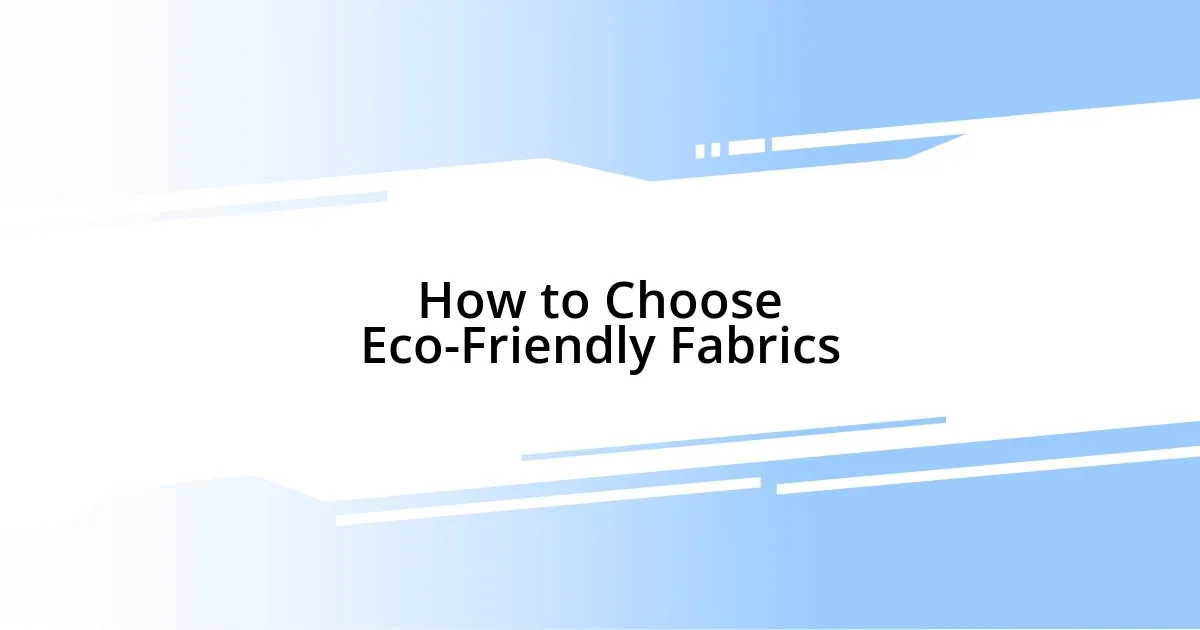
How to Choose Eco-Friendly Fabrics
When it comes to choosing eco-friendly fabrics, I always start by looking for certifications. For example, GOTS (Global Organic Textile Standard) or OEKO-TEX can be valuable indicators of sustainable practices. The first time I spotted a GOTS label in a store, it felt like discovering a secret badge of honor—an assurance that what I was buying was genuinely good for the planet.
Another factor I consider is the production process. I’ve learned that fabrics like organic cotton use non-toxic dyes and avoid harmful chemicals. The shift to gentle dyeing methods resonated deeply with me when I realized how beneficial it is for both the planet and my skin. Did you know that some dyes can trigger allergic reactions? Knowing this, I’m inclined to choose garments that prioritize safe methods.
Also, I pay attention to the fabric’s lifecycle. Does it biodegrade? Can it be recycled? I vividly remember the day I purchased a linen dress that promised biodegradability. It felt exciting to wear something that wouldn’t just end up in a landfill! Every time I wear that dress, I feel more connected to the environmental impact of my choices, reinforcing the notion that even small decisions can lead to significant change.
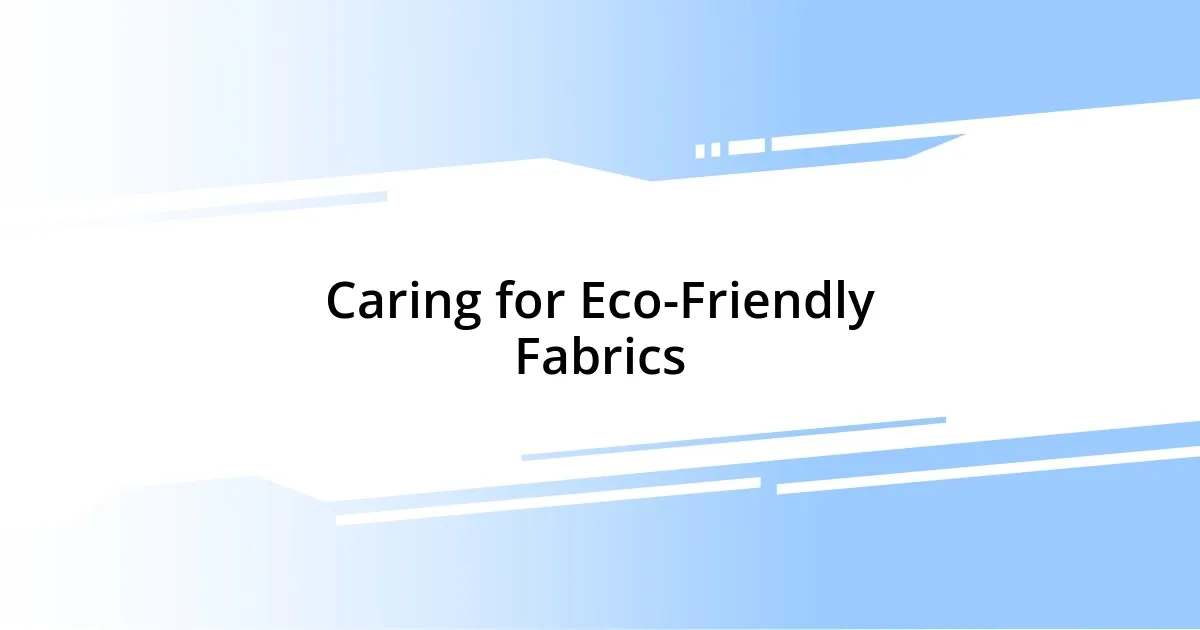
Caring for Eco-Friendly Fabrics
Caring for eco-friendly fabrics is a delightful journey that requires a bit of mindfulness. When I first embraced these materials, I quickly realized the importance of gentle washing. Most of my eco-friendly garments are made from delicate fibers, so I always opt for cold water and biodegradable detergents. It feels rewarding to know that I’m not just being kind to my clothes, but also to the environment with every wash.
Drying methods matter too. I’ve learned to steer clear of heat-generating dryers because they can be harsh on natural fibers. Instead, I hang my clothes to dry whenever possible. There’s something so refreshing about the sunlight gently warming my linen shirts or hemp skirts—it’s a small step that prevents wear and tear, and honestly, they smell beautifully fresh when they come off the line!
I also make a point to care for my eco-friendly items with proper storage. This might sound simple, but I’ve noticed a significant difference in the longevity of my wardrobe. For instance, I always store my cotton pieces in breathable fabric bags to protect them from pests and dust. I’ve even started using organic lavender sachets, which not only keep my clothes safe but also add a lovely scent. It’s little rituals like these that transform fabric care into an environment-friendly practice, making it easier for me to feel connected to my sustainable lifestyle. Doesn’t it feel great to know that so much care can extend the life of our eco-conscious choices?
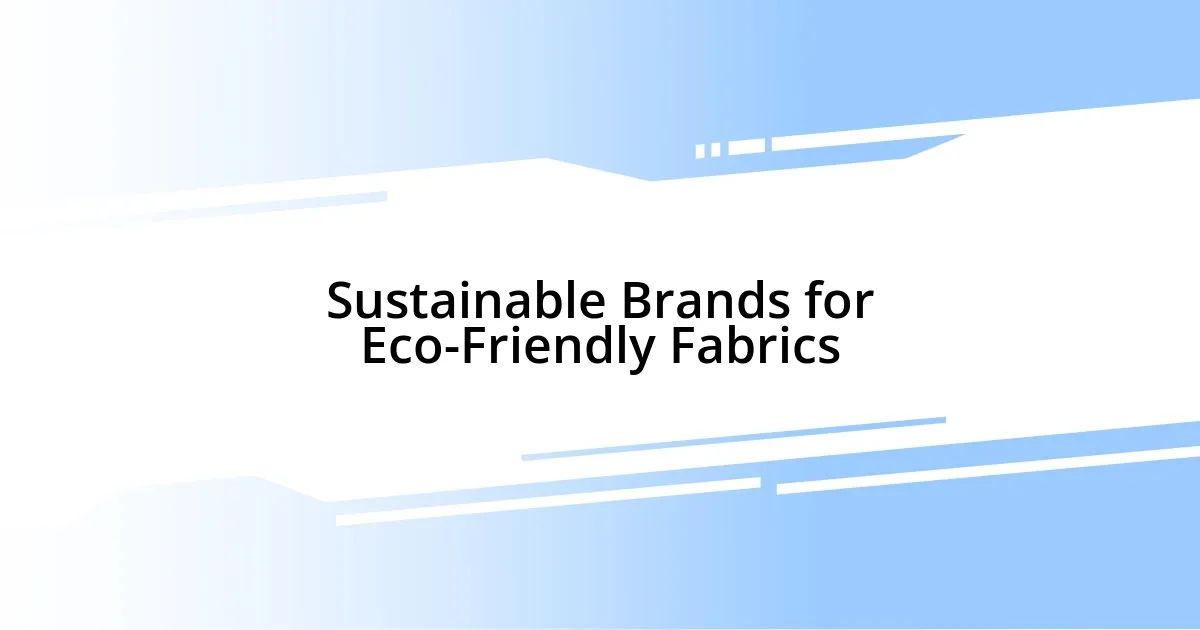
Sustainable Brands for Eco-Friendly Fabrics
I’m thrilled to share some sustainable brands that I’ve come to trust for eco-friendly fabrics. One of my personal favorites is Pact. Their organic cotton basics are so soft; I still remember the first time I wore one of their t-shirts—it felt like a warm hug! Plus, knowing that they prioritize fair labor practices makes each wear feel meaningful. It’s like wearing a piece of my values.
Another brand that consistently impresses me is Eileen Fisher. Their commitment to circular fashion resonates deeply with my belief in reducing waste. I have a sweater from them that I’ve worn for years, and every time I pull it out, it reminds me of the eco-conscious choice I made. Have you ever held onto a piece of clothing that just feels right?
Lastly, I can’t overlook Reformation, known for its vibrant styles and eco-friendly materials. I once found a stunning dress that turned heads at a gathering. What surprised me most was how light and breathable it felt, making me wonder why I hadn’t made this switch sooner. It just goes to show that sustainable fashion can be both beautiful and responsible. My closet decisions have become so much more intentional lately, don’t you think that every little choice we make can lead to a larger impact?
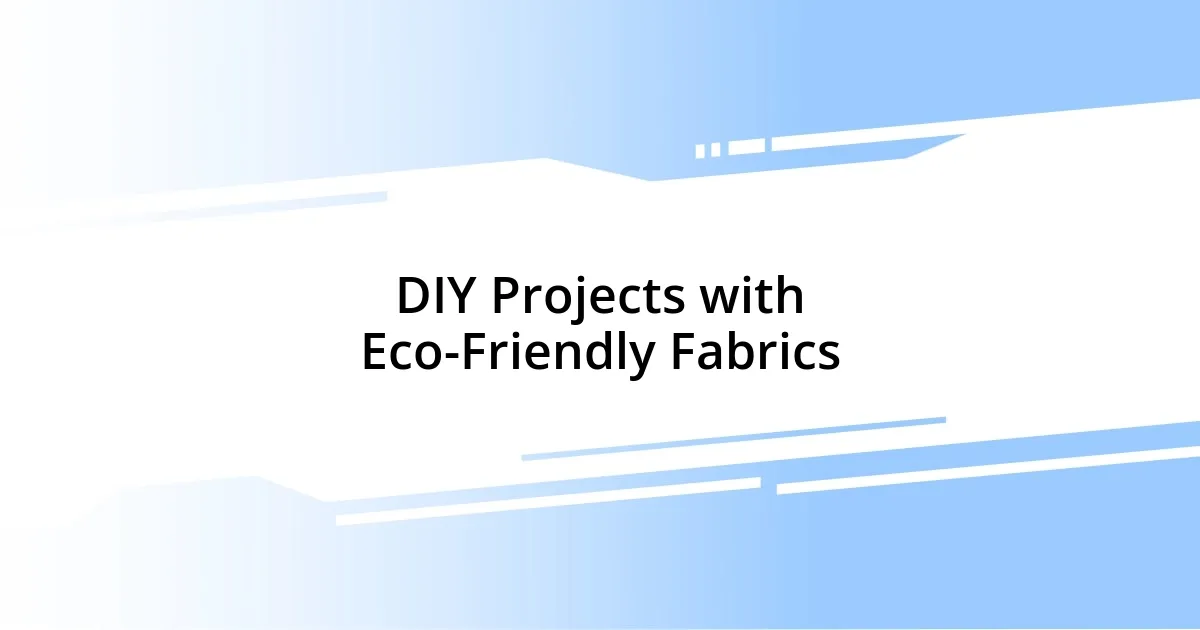
DIY Projects with Eco-Friendly Fabrics
I love diving into DIY projects with eco-friendly fabrics because it feels so fulfilling to create something unique while being kind to the planet. Last summer, I transformed some old organic cotton sheets into reusable shopping bags. Not only did I enjoy the process of sewing and designing, but I also felt a great sense of satisfaction knowing I was reducing plastic waste every time I went grocery shopping. Have you ever felt that rush of pride from using something you made yourself?
Another project that stands out in my memory is making fabric coasters from remnants of hemp canvas. The rugged texture adds a beautiful natural element to my coffee table, and every sip of tea feels more special when paired with a piece of my own creation. Plus, when friends come over, I can’t help but mention that they’re made from sustainable materials—it’s a great conversation starter! Isn’t it wonderful how DIY can spark discussions about sustainability?
I started crafting fabric wall art using scraps of linen and organic cotton, and it’s been a game-changer for my home décor. Just the other day, I completed a vibrant patchwork piece that now hangs above my couch. Not only does it add color to my living room, but it also serves as a reminder of the beauty of reusing and repurposing. Each time I glance at it, I’m reminded of how creativity and sustainability can blend seamlessly. Have you ever considered how your own creativity might lead to eco-friendly changes in your space?
